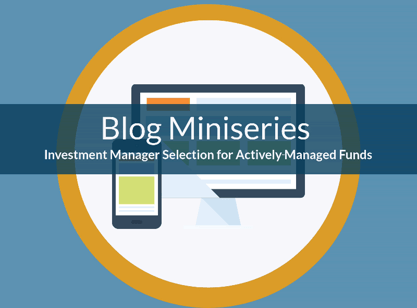 Retirement plan investment menu design depends on two key decisions: what asset classes are to be included and what mutual funds (or other investment vehicles) should be used. In our investment manager selection miniseries, we will discuss how Multnomah Group conducts the investment manager due diligence that underlies our actively-managed fund recommendations. Over the course of several blog posts we will discuss how we evaluate philosophy and process, portfolio construction and risk controls, and team structure. Our blog post miniseries will conclude with an in-depth white paper delving into the heart of Multnomah Group’s investment manager selection.
Retirement plan investment menu design depends on two key decisions: what asset classes are to be included and what mutual funds (or other investment vehicles) should be used. In our investment manager selection miniseries, we will discuss how Multnomah Group conducts the investment manager due diligence that underlies our actively-managed fund recommendations. Over the course of several blog posts we will discuss how we evaluate philosophy and process, portfolio construction and risk controls, and team structure. Our blog post miniseries will conclude with an in-depth white paper delving into the heart of Multnomah Group’s investment manager selection.
To kick off the series, we’re taking a moment to explain our philosophy on the construction of an actively-managed fund menu or menu “tier”.[1]
The primary objective of investment menu design is to provide participants with the building blocks of a properly diversified portfolio. At the same time, we need to ensure that participants don’t become overwhelmed by the number of choices available and make adverse decisions (or make no decisions). In order to balance these needs, we believe that the best design for an actively-managed fund menu provides fund options that are differentiated by asset class and investment style. While the needs of each plan may differ based on participant population and retirement benefit design, a basic investment menu should include the following asset classes:
- core or core “plus” bond
- large value
- large growth
- small value
- small growth
- foreign large value
- foreign large growth
Some employers may prefer to expand the menu a bit further to include asset classes such as real estate or emerging markets equity, but the principles here remain the same: the investment options should be distinct and differentiated. An optimal retirement plan menu includes “style-pure” options: fund managers that are dedicated to either value or growth, not managers who wander between these styles based on market movements. And while historical returns are not an indicator of future results, we look for managers who have demonstrated a commitment to their investment philosophy and process as this is the best means available to ensure that returns are repeatable, and not a function of luck.
Keep an eye out for the next episode in our miniseries: Philosophy & Process.
Notes:
[1] For the purpose of this series, we’ve specifically excluded asset allocation funds (including target date funds) and index funds due to their differing considerations in due diligence and menu construction needs.
Multnomah Group is a registered investment adviser, registered with the Securities and Exchange Commission. Any information contained herein or on Multnomah Group’s website is provided for educational purposes only and does not intend to make an offer or solicitation for the sale or purchase of any specific securities, investments, or investment strategies. Investments involve risk and, unless otherwise stated, are not guaranteed. Multnomah Group does not provide legal or tax advice.
Any views expressed herein are those of the author(s) and not necessarily those of Multnomah Group or Multnomah Group’s clients.

